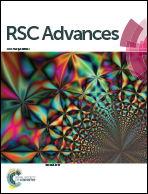Development of bio-derived nanostructured coordination polymers based on cardanol–formaldehyde polyurethanes with ‘d5’ Mn(ii) and ‘d10’ Zn(ii) metal nodes: synthesis, characterization and adsorption behavior
Abstract
The synthesis of bio-based coordination polyurethanes (PUs) is an alternative route to conventional petro-based PUs for the green and sustainable development of coordination PUs. In the present study, we report the development of bio-based nanostructured coordination PUs with the aid of using cost effective, non-toxic, biodegradable and abundantly available renewable resource such as cardanol (Col) as a starting precursor and divalent transition metal ions Mn(II), ‘d5’ and Zn(II), ‘d10’ as metal centres for their potential use in the adsorption/removal of environmental pollutants, such as Congo red (CR) dye, in industrial waste water treatment. The composition and geometry of coordination PUs were confirmed by spectral techniques (FTIR and UV-visible), elemental analysis and magnetic moment. The curing behavior was investigated using ATR-FTIR technique. Thermal techniques (TGA/DTG/DTA and DSC) indicated their good thermal stability. Morphology (XRD, SEM-EDX, and HR-TEM) techniques indicated their amorphous/semi-crystalline and layered nanostructured and nanoporous patterns. The preliminary adsorption properties towards CR dye of the synthesized coordinated PUs was also investigated by a batch adsorption technique and it was found that the synthesized nanostructured and nanoporous coordination PU could be used as an effective dye adsorbent.


 Please wait while we load your content...
Please wait while we load your content...